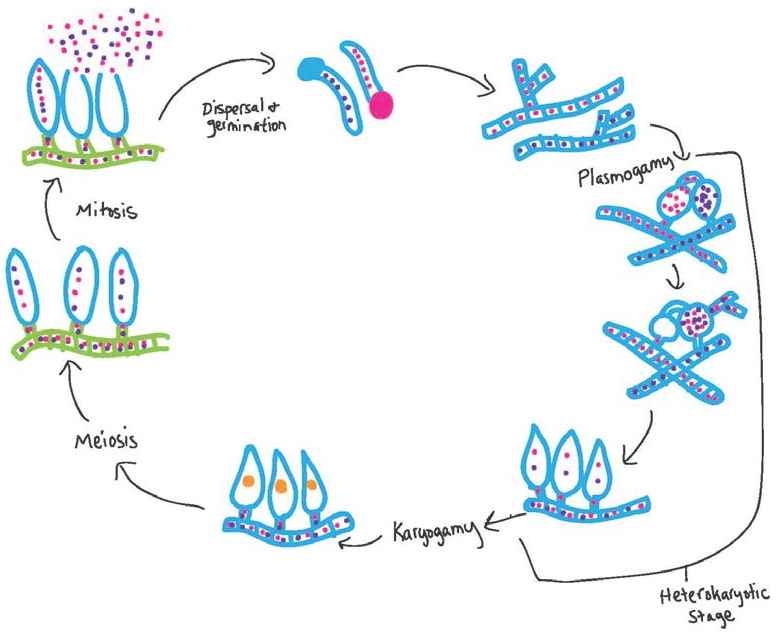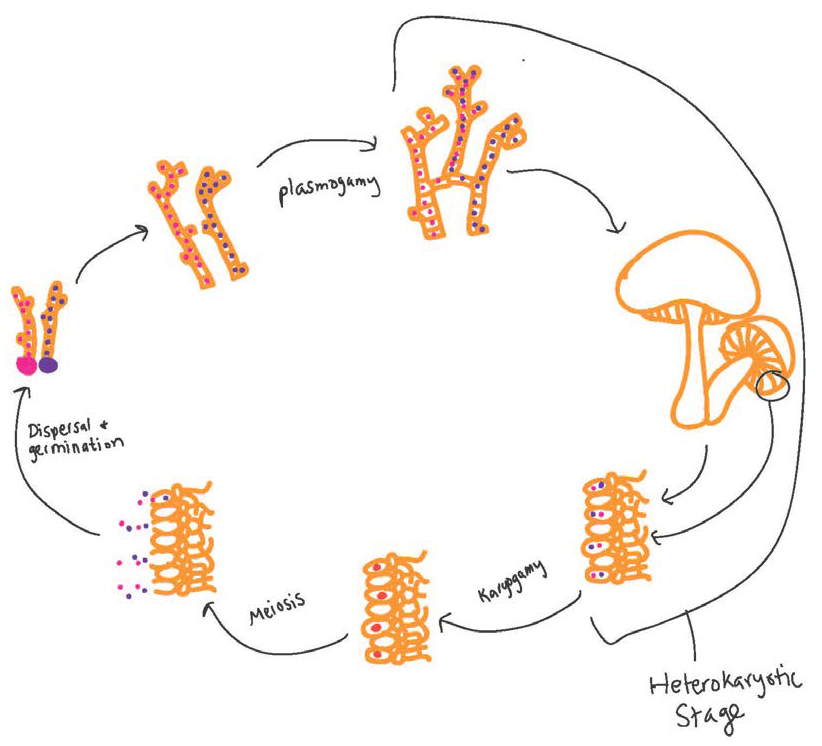CHAPTER SUMMARY
34.1 FUNGI ARE HETEROTROPHIC EUKARYOTES THAT FEED BY ABSORPTION.
- Fungi are heterotrophs that depend on preformed organic molecules for both carbon and energy.
- Fungi break down their food and then absorb it.
- Fungi use the process of growth to find and obtain food in their environment.
- Most fungi have numerous branched filaments called hyphae, which they use to absorb nutrients.
- When fungi encounter a rich source of food, their hyphae form a network called a mycelium.
- Fungal cell walls are made of chitin, the same compound found in the exoskeletons of insects.
- In early fungal groups, the hyphae form a continuous compartment, with many nuclei but with no cell walls, but in later evolving groups, nuclear divisions are accompanied by the formation of septa that divide the cytoplasm into separate cells.
- Some fungi, such as yeasts, do not produce hyphae.
- Most fungi feed on dead organic matter.
- Fungi are critical elements of the carbon cycle, converting dead organic matter back into carbon dioxide and water.
- Many fungi feed on living animals and plants, causing diseases.
- Fungi have repeatedly evolved mutually beneficial relationships with plants and animals.
- Lichens are stable associations between a fungus and a photosynthetic microorganism that look, function, and even reproduce as single organisms.
34.2 FUNGI REPRODUCE BOTH SExUALLY AND ASExUALLY, AND DISPERSE BY SPORES.
- Fungi produce haploid spores that are dispersed by wind, water, or animals.
- Spores can be produced asexually (by mitosis) or sexually (by cell fusion and meiosis).
- Many fungi produce spores within multicellular fruiting bodies that enhance spore dispersal.
- The fungal life cycle is similar to haploid-dominant life cycles found in many eukaryotic organisms, except that plasmogamy (cell fusion) and karyogamy (nuclear fusion) are often separated, resulting in a stage in which there are genetically distinct haploid nuclei in one cell, called a heterokaryotic stage.
- Genetically determined mating types prevent self-fertilization in many fungi.
- Asexual fungal species have mechanisms of generating genetic diversity, including a parasexual cycle, which involves crossing over in mitosis and chromosome loss.
34.3 NEXT TO THE ANIMALS, FUNGI ARE THE MOST diverse GROUP OF EUKARYOTIC ORGANISMS.
- About 75,000 fungal species have been formally described, but total diversity may be as high as 5 million species.
- The chytrids, a small group of about 1000 species, are at the base of the fungal tree.
- Zygomycetes produce hyphae without septa and make up less than 1% of known fungal diversity.
- The glomeromycetes are a group of fungi of low diversity but tremendous ecological importance due to their association with plant roots.
- Most fungi belong to the Dikarya (ascomycetes and basidiomycetes), which form septa along hyphae. During the heterokaryotic stage, these fungi produce cells that contain two haploid nuclei, one from each parent.
- Ascomycetes include wood-rotting fungi, many ectomychorrizal species, plant and animal pathogens, the fungal partner in most lichens, and baker’s and brewer’s yeasts.
- Basidiomycetes include familiar toadstools and puffballs, as well as plant pathogens.
Self-Assessment Question 1
Describe two ways in which fungi differ from other heterotrophic organisms in how they obtain and digest their food.
Show Model Answer
Model Answer:
Fungi do not have organs that enable them to ingest and digest food. Instead, fungi absorb molecules directly through their cell walls after they have first digested the material through the release of enzymes. Fungi are also unable to move to find food; thus, they grow to find nourishment.
Self-Assessment Question 2
Explain how hyphae and cell walls made of chitin allow fungi to obtain nutrients from their environment.
Show Model Answer
Model Answer:
Hyphae are numerous long, thin filaments that provide a large surface area for absorbing nutrients. Hyphae grow at the tip, elongating and penetrating into new environments where they may encounter water and new food resources. Chitin allows the cell walls of hyphae to be flexible but strong when compared to plant cell walls. The cell wall also prevents the cell from rupturing, and it contributes to the formation of positive turgor pressure, the force that allows the hyphae to penetrate deeper into their surroundings.
Self-Assessment Question 3
Describe how fungi contribute to the terrestrial (land-based) carbon cycle.
Show Model Answer
Model Answer:
Fungi convert dead organic matter back to CO2 and water, thus returning nutrients to the soil where they will be available for plant growth. In particular, fungi are the major decomposers of the cellulose and lignin in wood.
Self-Assessment Question 4
Name the two organisms that make up a lichen and describe how each partner benefits from the association.
Show Model Answer
Model Answer:
Lichens are made up of a fungus and a photosynthetic microorganism such as green algae or cyanobacteria. The hyphae of the fungus anchor the lichen, aid in the uptake and retention of water and nutrients, and produce chemicals that protect against excess light and herbivorous animals. The photosynthetic microorganism provides a source of reduced carbons and, in some cases, fixed nitrogen.
Self-Assessment Question 5
Describe how fungi disperse.
Show Model Answer
Model Answer:
Fungi disperse through the release of spores. A fungus will produce a huge number of spores that will be carried by the wind, water, or animals to different environments. A spore will start to grow only if it is in a suitable environment.
Self-Assessment Question 6
Draw the life cycle of an ascomycete, and indicate the heterokaryotic stage.
Show Model Answer
Model Answer:

Self-Assessment Question 7
Draw the life cycle of a basidiomycete, and indicate the heterokaryotic stage.
Show Model Answer
Model Answer:

Self-Assessment Question 8
Name and describe several key innovations in the evolutionary history of fungi that allowed them to move from water to land.
Show Model Answer
Model Answer:
Several key innovations in the evolutionary history of fungi allowed these organisms to move from water to land. The first was chitin; its flexible yet strong nature allowed the fungal cells to live in a non-aquatic environment. The second was hypha―these growths allowed fungi to explore the land environment in search of nutrients and water. Finally, there was the evolution of aerial spores and the structures releasing them, which helped fungi disperse their spores successfully on land.
Self-Assessment Question 9
Explain how the evolution of vascular plants has provided opportunities for fungal diversification.
Show Model Answer
Model Answer:
Since major groups of fungi, the ascomycetes and the basidiomycetes, associate with different plants and animals, diversity in the plants has corresponded to increased diversity in the fungal species.